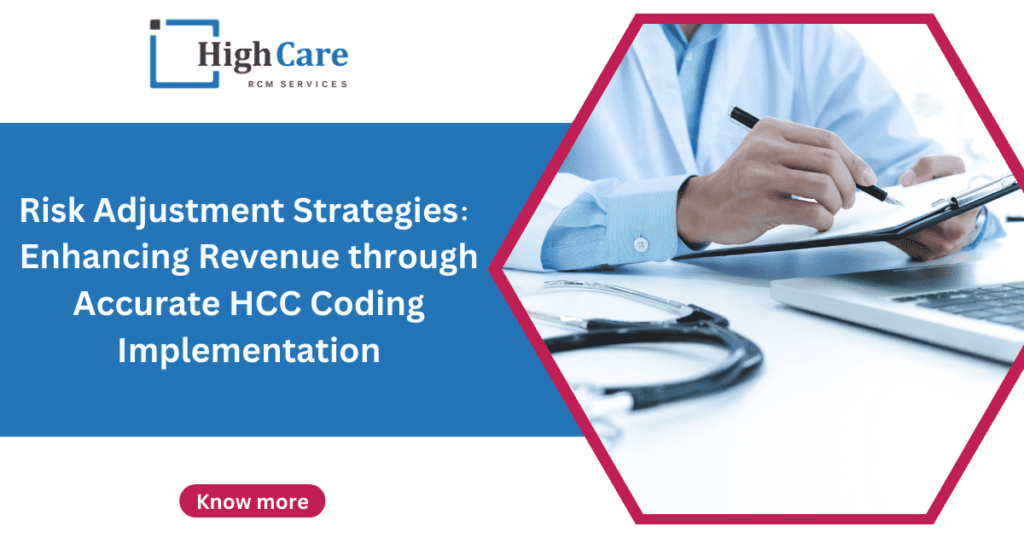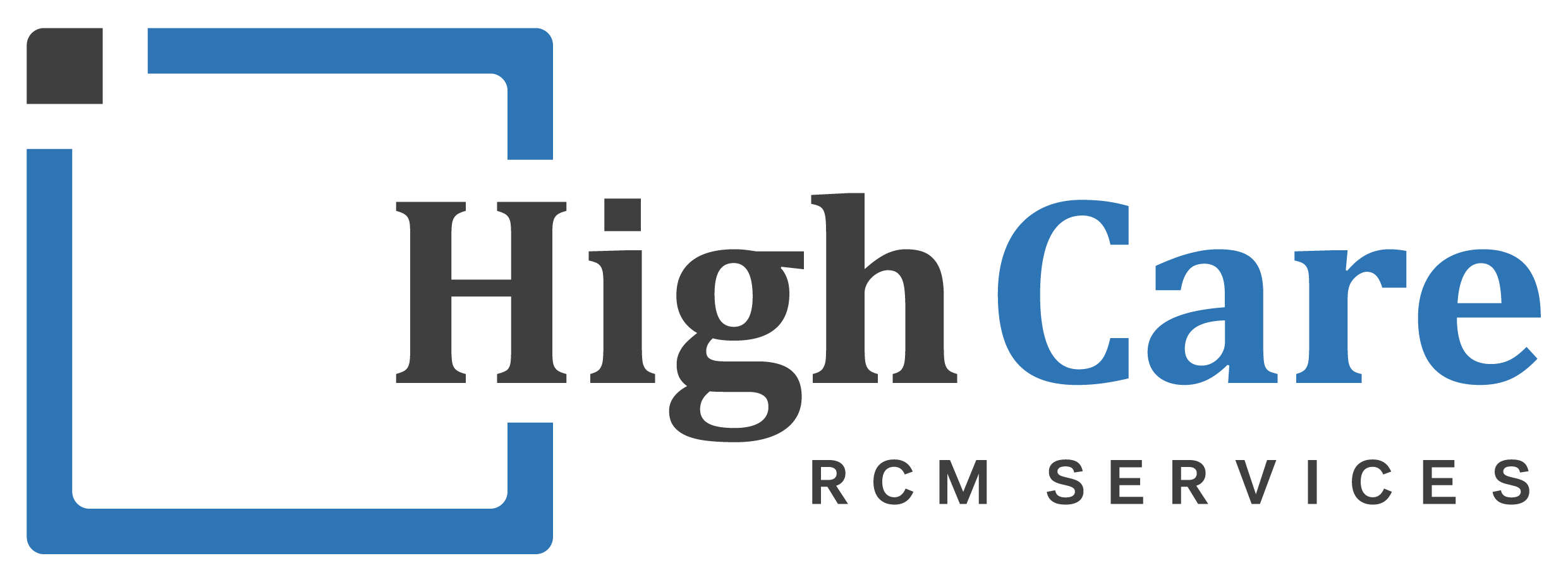- 14, Kathiresan Street, Pallipalayam corner, Kumarapalayam – 638183
Risk Adjustment Strategies: Enhancing Revenue through Effective HCC Coding Implementation
High Care RCM
In today’s healthcare industry, risk adjustment has become a crucial aspect of revenue optimization for healthcare organizations. Hierarchical Condition Category (HCC) coding is a system used by Medicare and other payers to adjust payments based on the health status of patients. In this article, we will explore the importance of risk adjustment, discuss the fundamentals of HCC coding, and provide actionable insights to enhance revenue through effective HCC coding implementation.
Risk Adjustment
Risk adjustment is a method used by healthcare payers to address the variations in the health status of individual patients and predict the costs associated with their care. This mechanism aims to ensure that patients with more intricate medical conditions receive fair reimbursement, safeguarding healthcare organizations from facing financial burdens when caring for sicker populations. By precisely capturing patient risk, healthcare institutions can more effectively allocate resources, improve care quality, and optimize revenue streams.

Basics of Hierarchical Condition Category (HCC) Coding
HCC coding is a risk adjustment model that groups clinically related diagnosis codes with similar associated costs to the healthcare system. HCC risk adjustment model assigns a risk score, also called the risk adjustment factor (RAF) to each category. A patient’s RAF is based on their clinical conditions, as well as demographic factors such as Age, Gender, Medicaid and disability status, and whether a patient lives in the community or in an institution, like a Skilled Nursing Facility. The higher the RAF score, the higher the expected healthcare costs, resulting in increased reimbursement for healthcare providers.
Accurate HCC coding and risk adjustment play a crucial role in the financial viability and quality of care provided by the healthcare organizations. To implement effective HCC coding, consider the following steps:
Comprehensive Documentation:
Encourage healthcare providers recording all relevant diagnoses and conditions completely and accurately. The documentation should be specific, well-supported by medical evidence, and reflect the severity and complexity of each patient’s health status. Clear and detailed documentation is crucial for justifying the assigned HCC codes and maximizing risk adjustment accuracy.
Annual Wellness Visits (AWVs):
Schedule annual wellness visits for patients, allowing physicians sufficient time to conduct comprehensive assessments and document chronic conditions and any new health concerns. AWVs provide an excellent opportunity for early detection and monitoring of chronic illnesses, ensuring that all pertinent diagnoses are adequately captured for risk adjustment purposes.
Capture All Diagnoses:
It is vital to have a robust coding team that is well-versed in HCC coding guidelines and has a keen eye for detail. During each patient encounter, ensure that all relevant diagnoses are captured accurately in the medical records. Missing even a single diagnosis can significantly impact risk scores and reimbursement.
Coding Accuracy:
Investing in ongoing coder education and training is essential to maintain coding accuracy and compliance with evolving coding guidelines. Coding professionals should stay up-to-date with the latest coding changes and best practices to ensure that HCC coding is performed efficiently and in alignment with industry standards.
Incorporating these steps into the HCC coding process can lead to more precise risk adjustment, allowing healthcare organizations to better allocate resources, improve financial viability, and enhance the overall quality of care delivery.
Leveraging Technology for Efficient HCC Coding
Leveraging technology can revolutionize the HCC coding process, streamlining operations and enhancing accuracy. Here are some effective ways to incorporate technology for efficient HCC coding:
EHR Optimization. Customizing your Electronic Health Records (EHR) system to include HCC coding prompts can significantly improve the accuracy of documentation. By creating tailored templates and forms, physicians are reminded to include specific diagnoses during patient encounters, ensures no relevant information is missed.
Natural Language Processing (NLP). Integrating NLP tools into the coding workflow to analyze the unstructured data within medical records. NLP algorithms can extract pertinent medical information from these unstructured sources and convert it into actionable codes. This saves time for coders and minimizes the risk of missing diagnoses.
Data Analytics. Employing data analytics can provide valuable insights into the coding process. By analyzing vast amounts of coding data, organizations can identify coding gaps, patterns, and trends. Data analytics can highlight potential areas for improvement, such as under-coded conditions or missed opportunities to capture relevant diagnoses.
By embracing technology, healthcare organizations can improve the overall HCC coding process, reduce the risk of coding errors, and ensure appropriate reimbursement for the care provided while providing quality care to patients.
Continuous Quality Improvement
By adopting a proactive approach to enhancing coding practices, healthcare organizations can optimize risk adjustment accuracy and ensure proper reimbursement. Here are key strategies for continuous quality improvement in HCC coding:
Regular Audits. Conducting regular internal audits is essential to evaluate the coding accuracy and compliance with coding guidelines. Through these audits, organizations can implement corrective actions, provide targeted feedback to coders, and track progress over time to drive ongoing improvement.
Physician Education. Educating physicians about the significance of complete documentation is crucial for accurate HCC coding. When physicians understand how their documentation directly impacts patient care and the financial health of the organization, they become more engaged in providing thorough and specific medical information.
Coding Team Collaboration. Encouraging collaboration between coding teams, physicians, and hospital administrative staffs is key to overcoming coding challenges and sharing best practices. Coders can benefit from insights shared by physicians about specific patient conditions, while physicians can gain a better understanding of coding requirements.
At High Care RCM Services, we recognize the critical role that risk adjustment plays in optimizing revenue for healthcare organizations. With a steadfast commitment to excellence, we are here to support your healthcare organization on its journey towards financial prosperity.
Our experienced team of professionals understands the intricacies of risk adjustment and HCC coding, ensuring that every diagnosis is accurately captured and appropriately coded. Contact us today and embark on a transformative journey towards enhanced revenue, optimized financial health, and delivering quality care to patients. With High Care RCM Services, you are in caring hands, and your success is our priority.
Tags: How to Improve Risk Scores, How to Improve RAF, Risk Adjustment Process, Importance of Accurate Hierarchical Condition Category (HCC) Coding

